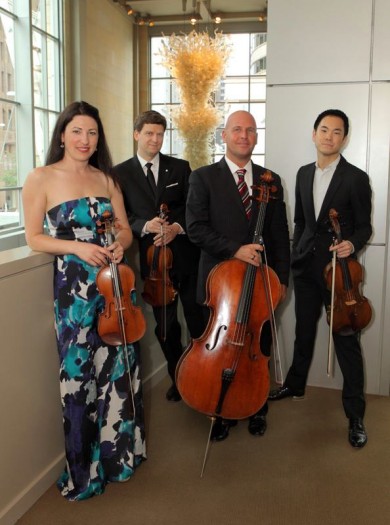Ehnes Quartet brings emotional depth and sterling artistry to Beethoven

The Ehnes Quartet performed an all-Beethoven program for Friends of Chamber Music Monday night in Coral Gables.
Some string quartets work together continually, the players rarely working with other artists or in different configurations. Others come together part of the year while its members pursue active careers as solo or orchestral players.
While it may seem that the full-time model would produce the best performances, that is not necessarily the case. The Ehnes Quartet, which returned with an all-Beethoven program for the Friends of Chamber Music Monday night, is proof that musicians who are widely active in other performing and teaching positions can come together to produce music making on the highest level.
From the moment violinist James Ehnes and his colleagues took the stage at Coral Gables Congregational Church, the quartet offered finely chiseled ensemble playing and probing interpretive visions of the many sided master from Bonn.
The String Quartet No. 5 in A Major is youthful Beethoven, rich in melody and spirited invention. The players’ vigorous attack at the onset of the initial Allegro never abated throughout the movement. A lovely Allegretto was unhurried and aristocratic with the sudden abrupt chords that interrupt the main theme, a Haydnesque joke, given emphatic weight.
Ehnes, a superb soloist in his own right, gave a formidable display of virtuosity in the Andante cantabile but his soaring tone blended seamlessly with second violin Amy Schwartz Moretti. The theme and variations emerged as one elongated stream of melody, moving from gutsy sinew to graceful moments. Lightness, speed and ease of projection informed the whirlwind final Allegro.
The opening chords of the Quartet No. 11 in F Major announce a different Beethoven. Despite the relentless tempo throughout the stormy and dramatic first movement, the players’ tone remained evenly balanced and devoid of roughness. Richard O’Neill’s deep viola sonority shone impressively in the second movement, firm and strongly present while always finely blended. The Allegro assai vivace third movement was hard driving and strongly accented but never at the expense of precision. In the darkly romantic finale, played with concentrated intensity, even the most fierce moments were rendered with a nuanced variety of tone and dynamics.
The Quartet No. 15, Op. 132 is Beethoven’s penultimate complete chamber work. Robert DeMaine’s warm, suave cello sound launched the dark, mysterious introduction. Changes of meter were smoothly achieved and the four musicians’ sonority was almost orchestral in the ensuing Allegro, the playing fired up and full of vitality.
The Molto Adagio third movement is the score’s heart. This is Beethoven at the pinnacle of his creative powers, despite deafness and illness, searching for higher means of expression. The Ehnes foursome brought out the music’s ethereal beauty, allowing the long phrases to unfold quietly and slowly without exaggerated emphasis, a pitfall in many less musically astute renditions.
Sweeping contrasts between a robust march and energtic Allegro Appassionato completed a performance of rare distinction that combined awesome technique with a strong sense of the score’s elegiac darkness.
In response to a standing, shouting ovation, the quartet lightened up with a bright reading of the final movement of Beethoven’s early Quartet No. 4 that nicely combined vigor with a touch of charm and whimsy.
The Friends of Chamber Music season continues with the Brentano Quartet and violist Roberto Diaz 8 p.m. December 15 at Coral Gables Congregational Church. miamichambermusic.org
Posted in Performances
Leave a Comment
Tue Nov 17, 2015
at 12:51 pm
No Comments






